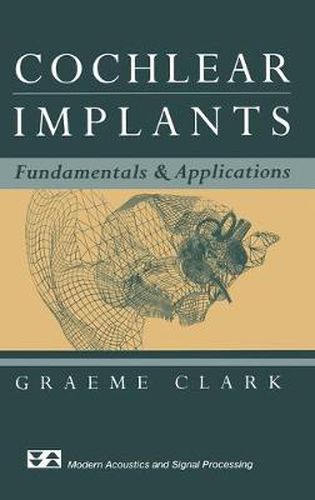Readings Newsletter
Become a Readings Member to make your shopping experience even easier.
Sign in or sign up for free!
You’re not far away from qualifying for FREE standard shipping within Australia
You’ve qualified for FREE standard shipping within Australia
The cart is loading…






This title is printed to order. This book may have been self-published. If so, we cannot guarantee the quality of the content. In the main most books will have gone through the editing process however some may not. We therefore suggest that you be aware of this before ordering this book. If in doubt check either the author or publisher’s details as we are unable to accept any returns unless they are faulty. Please contact us if you have any questions.
The cochlear implant is a device that bypasses a nonfunctional inner ear and stimulates the auditory nerve directly with patterns of electrical currents derived from incoming sounds. The culmination of investigations in many disciplines, it is the first major advance in helping profoundly deaf children communicate since the Sign Language for the Deaf was developed at the Institution des Jeunes Sourds in Paris some 200 years ago. Written by the father of the multi-electrode implant, this comprehensive text and reference gives an account of the fundamental principles underlying cochlear implants and their clinical application. It thus discusses research in all relevant disciplines, including: - Surgical anatomy, concentrating on essentials relevant to engineering - Pathology, focusing on the inner ear’s response to the implant and to electrical stimulation - Biophysics and electrochemistry, addressing the interface between electrode and tissue - Neurobiology, with particular emphasis on the issue of safety - Physiology, summarizing current theories of frequency and amplitude coding - Psychophysics, focusing on pitch and loudness perception - Speech science, including phonetics, perception, and language - Electronic principles of signal processing needed for speech perception - Clinical factors of importance to the engineering - Surgical procedures to help scientists and engineers understand the realities for implant development - Communication skills achieved for different speech processing strategies.
$9.00 standard shipping within Australia
FREE standard shipping within Australia for orders over $100.00
Express & International shipping calculated at checkout
This title is printed to order. This book may have been self-published. If so, we cannot guarantee the quality of the content. In the main most books will have gone through the editing process however some may not. We therefore suggest that you be aware of this before ordering this book. If in doubt check either the author or publisher’s details as we are unable to accept any returns unless they are faulty. Please contact us if you have any questions.
The cochlear implant is a device that bypasses a nonfunctional inner ear and stimulates the auditory nerve directly with patterns of electrical currents derived from incoming sounds. The culmination of investigations in many disciplines, it is the first major advance in helping profoundly deaf children communicate since the Sign Language for the Deaf was developed at the Institution des Jeunes Sourds in Paris some 200 years ago. Written by the father of the multi-electrode implant, this comprehensive text and reference gives an account of the fundamental principles underlying cochlear implants and their clinical application. It thus discusses research in all relevant disciplines, including: - Surgical anatomy, concentrating on essentials relevant to engineering - Pathology, focusing on the inner ear’s response to the implant and to electrical stimulation - Biophysics and electrochemistry, addressing the interface between electrode and tissue - Neurobiology, with particular emphasis on the issue of safety - Physiology, summarizing current theories of frequency and amplitude coding - Psychophysics, focusing on pitch and loudness perception - Speech science, including phonetics, perception, and language - Electronic principles of signal processing needed for speech perception - Clinical factors of importance to the engineering - Surgical procedures to help scientists and engineers understand the realities for implant development - Communication skills achieved for different speech processing strategies.